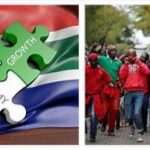The large waves of immigration in the latter half of the 19th century provided cheap labor for the rapidly growing North American industry. The US was rich in commodities, but the market was limited. This was the backdrop of the Declaration on the “Open Doors Policy” of 1899. The country expanded both economically and militarily, and soon became a world power with neo-colonial features. In spite of this, the United States perceived itself as an anti-colonialist nation, fighting the colonial systems of England and France.
Immediately after World War II, this anti-colonialism came into conflict with the strong anti-communist currents, which came to dominate US politics: Independence to the British and French colonies would mean increased danger of communist influence in the Third World. The United States thus embarked on a policy aimed at developing a “third path” between communism and colonialism: a policy oriented toward the formation of US-friendly, anti-communist governments.
Until the late 1980’s, US foreign policy has been focused on supporting liberal democratic movements where possible – Costa Rica, Venezuela, Japan – and supporting anti-communist governments where necessary – Greece, South Vietnam, Chile, Nicaragua, El Salvador, South Africa, Iran and Guatemala. Communist movements have been tolerated only in cases where the United States has been powerless – as in China and the Soviet Union.
This strategy has made the United States the greatest colonial power of our time. The country exercises economic power through its multinational corporations and military power through thousands of military bases worldwide. The United States is a member of the following multilateral military alliances: NATO, CENTO, ANZUS, OAS, the RIO Treaty and the Manila Treaty, and the country has bilateral agreements – defense or base agreements – with Antigua, the Bahamas, Bermuda, the Philippines, Greenland, Japan, Liberia, Morocco, Spain, South Korea, Taiwan, Trinidad and Tobago.
Another factor of power in US foreign policy was that the dollar, after North American pressure, was made into world currency (see IMF). This was important as long as the US had a balance in the foreign economy. But as Europe and Japan rebuilt after World War II and became a serious competitor to the United States itself, this system began to crack. The role of the United States as a world police officer led to large expenditures that exceeded the revenues the United States received from abroad. As a result, the US had a current account deficit – i.e. that North Americans spent more money overseas than they earned.
The United States tried to cover the current account deficit by printing more banknotes. But this undermined the value of the dollar and contributed to the dollar crisis that characterized the 1970’s. This development means that the United States is no longer the natural economic hub of international capitalism: the United States has faced increasingly fierce competition from the EU and Japan, which compete to sell goods on the world market and access to the raw material resources of developing countries. It is this economic competition that, among other things, is behind the crisis in NATO. The United States seeks to keep the alliance together by expanding to the east, recruiting new members, and entering into partnership for peace agreements. But at the same time, the United States is pursuing an economic policy that deepens tensions with its allies.
At the same time, the superpower has become increasingly dependent on imports of raw materials from the Third World. The oil supply in particular is a security policy concern. When the Shah of Iran crashed in 1979, the United States suddenly lost its most important oil supplier. North Americans immediately developed military plans to ensure that other oil sources in the Middle East should not fall into anti-American hands. In 1980, President Carter devised the so-called Carter Doctrine: The United States would perceive all attempts to gain control of the Persian Gulf area as a threat to vital North American interests; The United States would fight back any conquest attempt – with military force if necessary. The doctrine came into force in 1990, when the United States gathered a huge military force in Saudi Arabia, with the intention of throwing Iraq out of Kuwait (see Gulf War).
Many view this development with unrest, for the United States has interfered in more conflicts than any other country of this century: in the years 1945-76, a total of 120 wars were fought. Just over half of these were waged in the Third World and with the interference of Western powers. The United States militarily intervened in 27 of these wars. This policy led the United States to acquire client regimes, which came in stark contrast to the popular liberation movements. The use of secret actions against foreign countries and movements has made the intelligence organization CIA into a symbol of the power-political side of US foreign policy. The US client regimes have benefited from the generosity and idealism of the superpower through development assistance programs that in size surpass all other countries listed by Countryaah.com. But in most cases, these regimes have been corrupt and ineffective in managing this assistance in a way that benefits the population. According to AbbreviationFinder, the largest countries in North America are United States and Canada.
Nearly half of the conflicts that the United States interfered with after World War II occurred during the decade of 1964-74. This fierce commitment under Presidents Kennedy and Johnson had a decisive effect on 1970’s politics. The Vietnam War led to a crisis for North American interventionism because the traditional foreign policy agreement in US opinion crumbled away. It is predominantly the president who has been the outward force behind North American foreign policy. When the Vietnam War, along with the Watergate scandal, caused the president’s power to be severely cut, US foreign policy became rootless and contradictory.







